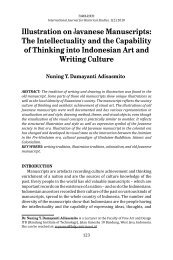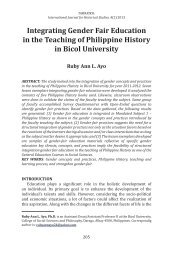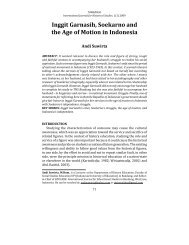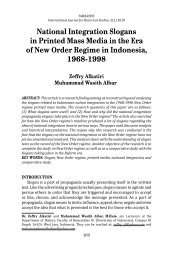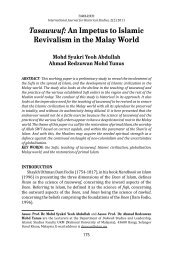to read the full text in PDF - Tawarikh Journal
to read the full text in PDF - Tawarikh Journal
to read the full text in PDF - Tawarikh Journal
You also want an ePaper? Increase the reach of your titles
YUMPU automatically turns print PDFs into web optimized ePapers that Google loves.
YUDA B. TANGKILISAN,The Impossible is Possibleagree with an idea that Indonesia is undergo<strong>in</strong>g a de<strong>in</strong>dustrialization.He always refers <strong>to</strong> <strong>the</strong> achievement and performance of manufactur<strong>in</strong>g<strong>in</strong>dustries. The sec<strong>to</strong>r was ever hit badly by <strong>the</strong> crisis, but it did not takemuch time <strong>to</strong> recover. 1Prior <strong>to</strong> 1970, some observers thought that it was hard for <strong>the</strong> country<strong>to</strong> achieve <strong>the</strong> welfare. Indonesia was characterized as a “chronic economicdropout” and as one of <strong>the</strong> poorest countries <strong>in</strong> <strong>the</strong> world. In this con<strong>text</strong>,Gunnar Myrdal stated that few chances for Indonesia <strong>to</strong> have a rapideconomic growth (cited <strong>in</strong> Hill, 2002:1). Moreover, no one would believethat Indonesia would be grouped as a member of <strong>the</strong> most exclusive clubof “East Asian Miracle Economies” and with <strong>the</strong> highest economic group<strong>in</strong> <strong>the</strong> world <strong>in</strong> just 20 years (Wulansari, 2004:3). Masami Ishida, quot<strong>in</strong>ga report of World Bank <strong>in</strong> 1993, stated also as follows:Dur<strong>in</strong>g <strong>the</strong> period from <strong>the</strong> latter half of <strong>the</strong> 1980s until just before <strong>the</strong> Asiancurrency crisis <strong>in</strong> 1997, Indonesia’s economic development had drawn expectationsand attention from various quarters, along with Malaysia and Thailand with<strong>in</strong> <strong>the</strong>same Association of South East Asian Nations (ASEAN). In fact, <strong>the</strong> 1993 repor<strong>to</strong>f World Bank entitled “East Asian Miracles: Economic Growth and Public Policy”recognized Indonesia as one of <strong>the</strong> East Asian economies with <strong>the</strong> strong economicperformance, i.e. susta<strong>in</strong>ed economic growth (Ishida, 2003:1).In 1980s, <strong>the</strong> Indonesian economics showed an <strong>in</strong>credible growth asa result of <strong>the</strong> implementation of PELITA (Pembangunan Lima Tahun or 5Years Development Plann<strong>in</strong>g) s<strong>in</strong>ce 1969. The public welfare <strong>in</strong>creased. ThePlann<strong>in</strong>g put <strong>the</strong> agricultural sec<strong>to</strong>r as <strong>the</strong> irst priority <strong>in</strong> order <strong>to</strong> provide <strong>the</strong>staple food for all people. Therefore, <strong>the</strong> production evolved. The period 1983<strong>to</strong> 1993 showed a rapid <strong>in</strong>dustrial progress. Sumitro Djojohadikusumo, anIndonesian senior and prom<strong>in</strong>ent economist, was impressed by <strong>the</strong> progress(cited <strong>in</strong> Tambunan, 2006). Anne Booth (2001), an Australian and economichis<strong>to</strong>ry of Indonesia expert, has a similar impression.After <strong>the</strong> 1982 General Election, <strong>the</strong> elected President formed hiscab<strong>in</strong>et. From <strong>the</strong> names, Hartar<strong>to</strong> Sastrosoenar<strong>to</strong> was <strong>in</strong> charge <strong>to</strong> lead <strong>the</strong>Department of Industry. This was a right choice because he had capabilitiesand experiences <strong>in</strong> <strong>the</strong> <strong>in</strong>dustrial ield. He has an academic background<strong>in</strong> <strong>the</strong> chemical eng<strong>in</strong>eer<strong>in</strong>g and began his career from <strong>the</strong> bot<strong>to</strong>m at <strong>the</strong>Department. Therefore, he endured many th<strong>in</strong>gs <strong>in</strong> handl<strong>in</strong>g <strong>in</strong>dustrialmatters, from <strong>the</strong> technical <strong>to</strong> adm<strong>in</strong>istrative ones. Moreover, he was ahard work<strong>in</strong>g man and a man of vision.1An early version of this article al<strong>read</strong>y delivered at <strong>the</strong> Conference of InternationalGraduate Students <strong>in</strong> Yogyakarta, Indonesia on December 2009.84



